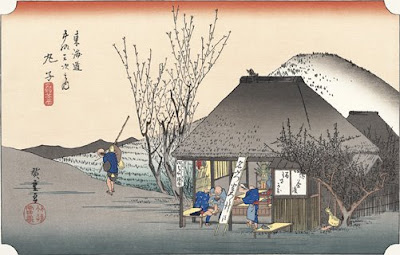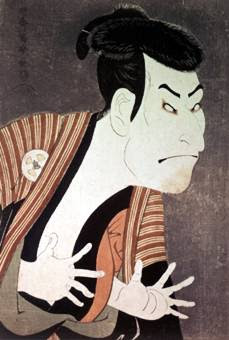::::::::::::::::::::::::::::::::::::::::::::::::::::::::::::::::::::::::::::::::::::::::::::::::::::
Woodblock prints with food
hanga 版画
kitte 切手 stamps with Japanese food
:::::::::::::::::::::::::::::::::::::::::::::::::::::::::::::::::::::::::::::::::::::::::::::::::::
Daruma Eating Buckwheat Noodles
Daruma Museum Japan
:::::::::::::::::::::::::::::::::::::::::::::::::::::::::::::::::::::::::::::::::::::::::::::::::::
Kasamori O-Sen serving dumplings
Children's song about the Kasamori dumplings
Let's to go the Fox Shrine over there.
Let's visit the teahouse of O-Sen.
Let's sit down and have some bitter tea!
Sip the tee and peek at her and then
dumplings from rice, dumplings from mud,
dumplings, dumplings, dumplings !
:::::::::::::::::::::::::::::::::::::::::::::::::::::::::::::::::::::::::::::::::::::::::::::::::::
Tororojiru とろろ汁
Soup with grated jinenjo yam, a speciality of the Shiga region.
自然薯(じねんじょ)
Here is a tea stall by the roadside with a sign of this soup.
On the right on the bench is an empty cup. And on the left a man is walking away, with a long pole and a heavy money bag dangling from his waist - so we might guess:
He is a local farmer who has sold his long Jinenjo Yam to the shop owner, enjoyed a drink and is now on his way home! Jinenjo were harvested and hung on long poles to be carried from the fields.

Utagawa Hiroshige : 'Mariko no Tororojiru'
Tokaido 53 Stations
歌川広重 "丸子 名物茶店"
Tea stall at Mariko 鞠子 (maruko)
This is the shop 丁子屋 , dating back to the year 1596年(慶長元年).
Mariko is number 21 on the Tokaido road, about 180 km from Edo. Now it is in Shizuoka prefecture. There used to be many shops like this one, but nowadays there is only one thatched house left which still looks like the old woodblock.
静岡市駿河区丸子7-10-10
The owner of the present shop has been collecting all the woodblock prints of Hiroshige about 丸子. There is another version of this station print, with the Chinese characters of 鞠子, depicting the whole village covered in winter snow.
. . . CLICK here for Photos !
. Abekawa Mochi 安倍川餅 / 安倍川もち
rice cakes from Abekawa river . .
At Fuchu, along the Tokaido
.................................................................................
Food hokku by
. Matsuo Basho 松尾芭蕉 - Archives of the WKD .
梅若菜丸子の宿のとろろ汁
ume wakana Mariko no yado no tororo jiru
plum blossoms and fresh leaves -
the yam soup at the lodgeing
at Mariko station
Tr. Gabi Greve
plum blossoms and fresh greens
at the Mariko stopover
and that yam porridge
Tr. Barnhill
plums and young greens
at the post town of Mariko
grated yam soup
Tr. Reichhold
For his Student Kawai Otokuni

. Tororo-jiru, kigo for all autumn
yam porridge, yam gruel, yam paste ... and more tororo dishes !
Mariko Station:
yam soup is less elusive
than Basho's haiku
Judy Anne Walter, May 11, 2002
Happy Haiku Forum, February 2012
:::::::::::::::::::::::::::::::::::::::::::::::::::::::::::::::::::::::::::::::::::::::::::::::::::
Nabe hodgepodge food

source : taxiee
:::::::::::::::::::::::::::::::::::::::::::::::::::::::::::::::::::::::::::::::::::::::::::::::::::

旅したい!おいしい浮世絵―NHK趣味どきっ! 2016
Traveling in Edo with Ukiyo-E prints and food !
江戸のすし Sushi / 江戸のうなぎ Unagi / 江戸の天ぷら Tempura / 江戸のそば Soba / 江戸のおやつ O-Yatsu snack
東海道名物 Tokaido / 京都の豆腐料理 Kyoto / 上方の清酒 Kamigata/Osaka
and
浮世絵に見る 江戸の食卓 Food of Edo seen in Ukiyo-E prints
林 綾野 Hayashi Ayano
. Edo, Food and Ukiyo-E - special .
:::::::::::::::::::::::::::::::::::::::::::::::::::::::::::::::::::::::::::::::::::::::::::::::::::
Ukiyo-e Bento
like a print from Toshusai Sharaku

source : charaben.at.webry.info
Original from Sharaku
Sandaime Otani Oniji no Yakko E Edobei
「三世 大谷鬼次の奴絵江戸兵衛」
三代目大谷鬼次 奴江戸兵衛
Tôshûsai Sharaku

Kabuki actor Otani Oniji performing the role of Yakko Edobei
From a play performed in 1794.
. . More imitations of this famous print ! 3代目

The Case of the Sharaku Murders
by Katsuhiko Takahashi Katsuhiko
- source : Japan Times, 2014
. inrō 印籠 / 印篭 / いんろう Inro, pillbox, pill box, Pillenschachtel .
with Sharaku design
:::::::::::::::::::::::::::::::::::::::::::::::::::::::::::::::::::::::::::::::::::::::::::::::::::::::::::::::::::::::::::
:::::::::::::::::::::::::::::::::::::::::::::::::::::::::::::::::::::::::::::::::::::::::::::::::::::::::::::::::::::::::::
kitte 切手 stamps with Japanese food
WASHOKU is now a world heritage - 2015.



.......................................................................
Hongkong

Solomon Islands

Japanese food
Katsuobushi used in Ishiban Dashi Tori Nanban also Aka Miso with their Recipe
For Phila Nippon 91 In Japan
::::::::::::::::::::::::::::::::::::::::::::::::::::::::::::::::::::::::::::::::::::::::::::::::::::
Morinaga Caramels

Japanese Sweets and Tea

source : kunio.raindrop.jp
Stamps about Food
More stamps about Asian Food !
*****************************
Related words
Wrapping Paper Art / Food Art
***** WASHOKU : General Information
:::::::::::::::::::::::::::::::::::::::::::::::::::::::::::::::::::::::::::::::::::::::::::::::::::::
[ . BACK to DARUMA MUSEUM TOP . ]
[ . BACK to WORLDKIGO . TOP . ]
:::::::::::::::::::::::::::::::::::::::::::::::::::::::::::::::::::::::::::::::::::::::::::::::::::::




6 comments:
ume wakana Mariko no yado no tororo jiru
This is a haiku that sounds at first like a simple scene without depth. There is a deeper side, when you put yourself Into the poem. Mariko station. Why is the poet there? The why's and want ford coupled with environment season and food paint cerebral pictures that effect each reader within the scope of their individual cultural memories. Poems written by others aren't for entertainment or for us to ascertain the poet's mindset. They are stimuli for thought and paths for us to explore. And it helps if the reader does his or her homework in order to understand the significance of terms, food, customs, and places during the time a given poem is written.
Arigato once again, Gabi San, for sharing with us the fruits of your haiku journey.
We learn much from you, sensei.
RW.
"Sharaku"
The Tokyo National Museum
By MIKE HAMILTON
Toshusai Sharaku's active career lasted a mere 10 months sometime in the years of 1794-95. Despite this brevity, his work has been acclaimed for its minimal and abbreviated but stylistic appearance. The mystery behind Sharaku's true identity — which is still unknown — also continues to fascinate the art world today.
He produced more than 140 pieces in those few months, a number that set the bar for Japanese woodblock art. This prolific output, however, has also led some to believe that Sharaku may have been group of artists working under the same name, particularly as many of his works show a number of stylistic changes.
Japan Times
Knowing Sharaku's art without knowing the artist
Tokyo National Museum's comprehensive show is haunted by the ghost of whodunit
By C.B. LIDDELL, Japan Times
One of Japan's greatest mysteries is the true identity of the ukiyo-e (woodblock print) artist Toshusai Sharaku, whose entire career was crammed into a 10-month period from 1794 to 1795, during which he produced 145 separate print sheets.
With practically no reliable biographical information about the artist, various theories have sprung up. One suggests that he was a Noh actor called Saito Jurobei, another that he was the renowned Katsushika Hokusai using another name. One even proposes that he wasn't a single person but rather a group of artists temporarily brought together by the publisher Tsutaya Juzaburo — who according to yet another theory may also have been Sharaku.
Perhaps a fear that such theories might detract from the art has led the Tokyo National Museum, in this comprehensive retrospective of the artist's work, to make the assumption that Sharaku was a distinct individual with a unique artistic identity. Rather than getting embroiled in biographical conundrums, the exhibition prefers to approach the artist in the only way we can truly know him — through his art, with 142 of his works brought together alongside dozens of prints by contemporaries, rivals and a few successors. As the exhibition catalogue optimistically puts it, "This exhibition seeks an understanding of the basis of Sharaku's creative genius, clarification of his formal expression and artistic characteristics, and confirmation of his oeuvre."
Yet, despite these intentions, the unexorcized ghost of Sharaku's mystery continues to haunt this show, with the artist's identity a shimmering and unstable thing. The four batches into which his work has been divided — based on editions of prints issued to coincide with the calendar of Edo Period (1603-1867) kabuki theater — raise more questions than they answer. For example, his art emerges fully developed and then undergoes radical changes in style, format, and materials, while also losing much of its power. This suggests, although not very conclusively, a change of personnel rather than the natural evolution of an individual artist.
Sharaku made his debut in the fifth month of 1794 with 28 half-length portraits of kabuki actors, featuring dark, mica-enhanced backgrounds rendered by a then new technique. This contrast threw the figures into sharp relief, rather like chiaroscuro painting in 17th-century Europe, adding to their dramatic impact. This batch includes many of his best and most famous works, such as the iconic "The Actor Otani Oniji III as Edobei," showing the actor in the role of a villain, with a look of intense hatred on his face and fingers outstretched ready to attack.
Other works, from this first supposed gush of creativity show onnagata (male kabuki actors playing female roles), such as "The Actors Iwai Kiyotaro II as Fujinami, Wife of Sagisaka Sanai," and "Bando Zenji as Kozasa, Wife of Washizuka Kandayu." In works like these, Sharaku chooses to juxtapose the masculinity of the actors with the femininity of their roles to comic and surreal effect.
http://search.japantimes.co.jp/mail/fa20110526a1.html
One of the ways Sharaku achieved this intensity was to use hands and costume to heighten and amplify the expressions on the subjects' faces. A good example is "The Actor Ichikawa Ebizo as Takemura Sadanoshin," a character who commits suicide in one of the plays. The tension is palpable through his clenched hands and the wrinkles in his face. These elements are also echoed in the numerous folds and claustrophobic appearance of his costume.
The next three batches of his work are dominated by full-length portraits of actors in which the face shrinks to a detail rather than being the main focus. These seem more compositional than psychological, with the costumes taking center stage. While there are still characteristic "Sharaku" touches, the overall feeling is of a fading brand name in the hands of lesser designers, but of course other explanations for this decline abound.
The artist and writer Ota Nanpo, who wrote "History of Floating World Prints" in the period after Sharaku, opined that his contemporaries were uncomfortable with what was considered Sharaku's excessive realism. Possibly this undermined his initial popularity and may have prompted his publisher, Tsutaya Juzaburo, to pressure him to switch to full-length portraits and "tone things down a bit." According to this view, these changes failed to revive Sharaku's fortunes and his art lost out to blander but more palatable works by the likes of Katsukawa Shun'ei. Unlike Sharaku's onnagata, who appear obviously as men, Katsukawa's are indistinguishable from women.
This is a show that rewards close study, but just like conspiracy theories, the more you delve into Sharaku, the more mysterious, inexplicable and baffling this enigma of Japanese art becomes.
"Sharaku" at the Tokyo National Museum
http://search.japantimes.co.jp/mail/fa20110526a1.html
Daidôzan Bungorô 大童山文五郎 Daidozan Bungoro
(1788 - 1822)
By Sharaku
Reference
国文学研究資料館と味の素食の文化センター(港区)は、研究者支援ならびに文化事業の発展のため、同センターが所蔵する江戸時代の料理書等約300点の画像について、平成29(2017)年5月(予定)からWEB上で一般公開いたします。
Over 300 items are digitized, including (see images on the pdf web link):
• 東籬亭主人(池田東籬)『魚類精進早見献立帳(ぎょるい しょうじんはやみこんだてちょう)』(天保5年) *魚料理と精進料理の紹介資料です。Recipe book dealing fish and shojin ryori cuisine;
• 醒狂道人何必醇『豆腐百珍(とうふひゃくちん)』(天明2年) On tofu and its one hundred variations (as in the present-day Sasa-no-Yuki tofu restaurant: < http://www.sasanoyuki.com >
*挿絵は豆腐田楽を焼いている様子。いわゆるとされているシリーズとして、他に『甘藷
百珍』『蒟蒻百珍』『鯛百珍料理秘密箱』『万宝料理
秘密箱』『柚珍秘密箱』が当コレクションに含まれています。
: https://www.nijl.ac.jp/…/cijproject/images/20160620_news.pdf
Home page of the National Institute of Japanese Literature: https://www.nijl.ac.jp/pages/cijproject/
味の素食の文化センター Ajinomoto Culinary Culture Center home page: http://www.syokubunka.or.jp
Post a Comment